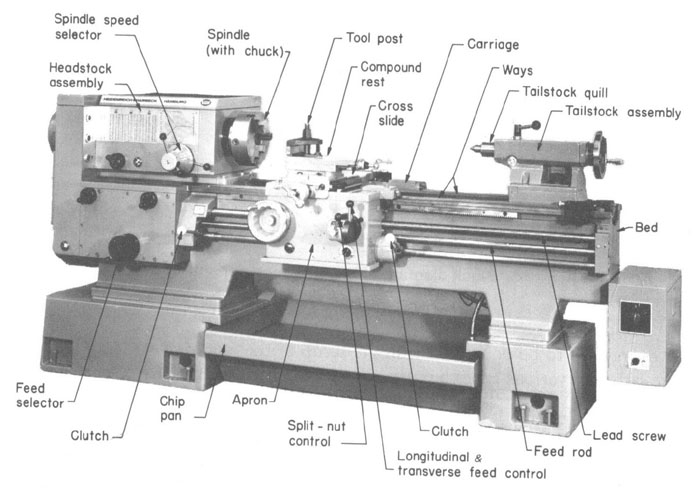|
Lathe Diagram
|
|||||
 |
|||||
DIAGRAM OF LATHE MACHINE

Explanation of the standard components of most lathes:
• Bed: Usually made of cast iron. Provides a heavy rigid frame
on which all the main components are mounted.
• Ways: Inner and outer guide rails that are precision machined
parallel to assure accuracy of movement.
• Headstock: mounted in a fixed position on the inner ways, usually
at the left end. Using a chuck, it rotates the work.
• Gearbox: inside the headstock, providing multiple speeds with
a geometric ratio by moving levers.
• Spindle: Hole through the headstock to which bar stock can be
fed, which allows shafts that are up to 2 times the length between lathe
centers to be worked on one end at a time.
• Chuck: 3-jaw (self centering) or 4-jaw (independent) to clamp
part being machined.
• Chuck: allows the mounting of difficult workpieces that are not
round, square or triangular.
• Tailstock: Fits on the inner ways of the bed and can slide towards
any position the headstock to fit the length of the work piece. An optional
taper turning attachment would be mounted to it.
• Tailstock Quill: Has a Morse taper to hold a lathe center, drill
bit or other tool.
• Carriage: Moves on the outer ways. Used for mounting and moving
most the cutting tools.
• Cross Slide: Mounted on the traverse slide of the carriage, and
uses a handwheel to feed tools into the workpiece.
• Tool Post: To mount tool holders in which the cutting bits are
clamped.
• Compound Rest: Mounted to the cross slide, it pivots around the
tool post.
• Apron: Attached to the front of the carriage, it has the mechanism
and controls for moving the carriage and cross slide.
• Feed Rod: Has a keyway, with two reversing pinion gears, either
of which can be meshed with the mating bevel gear to forward or reverse
the carriage using a clutch.
• Lead Screw: For cutting threads.
• Split Nut: When closed around the lead screw, the carriage is
driven along by direct drive without using a clutch.
• Quick Change Gearbox: Controls the movement of the carriage using
levers.
• Steady Rest: Clamped to the lathe ways, it uses adjustable fingers
to contact the workpiece and align it. Can be used in place of tailstock
or in the middle to support long or unstable parts being machined.
• Follow Rest: Bolted to the lathe carriage, it uses adjustable
fingers to bear against the workpiece opposite the cutting tool to prevent
deflection.
Click
to see our AMERICAN
TURNMASTER LATHES
Click for our Metal working LATHE page
Click for American Machine Tools Company Homepage
5864 Northwest Hwy
Chicago IL 60631 USA
Phone: 773-334-5000
Fax: 773-442-0314
Click to email us
Products and Logos in this website are trademarks or registered trademarks of their respective companies or mark holders.